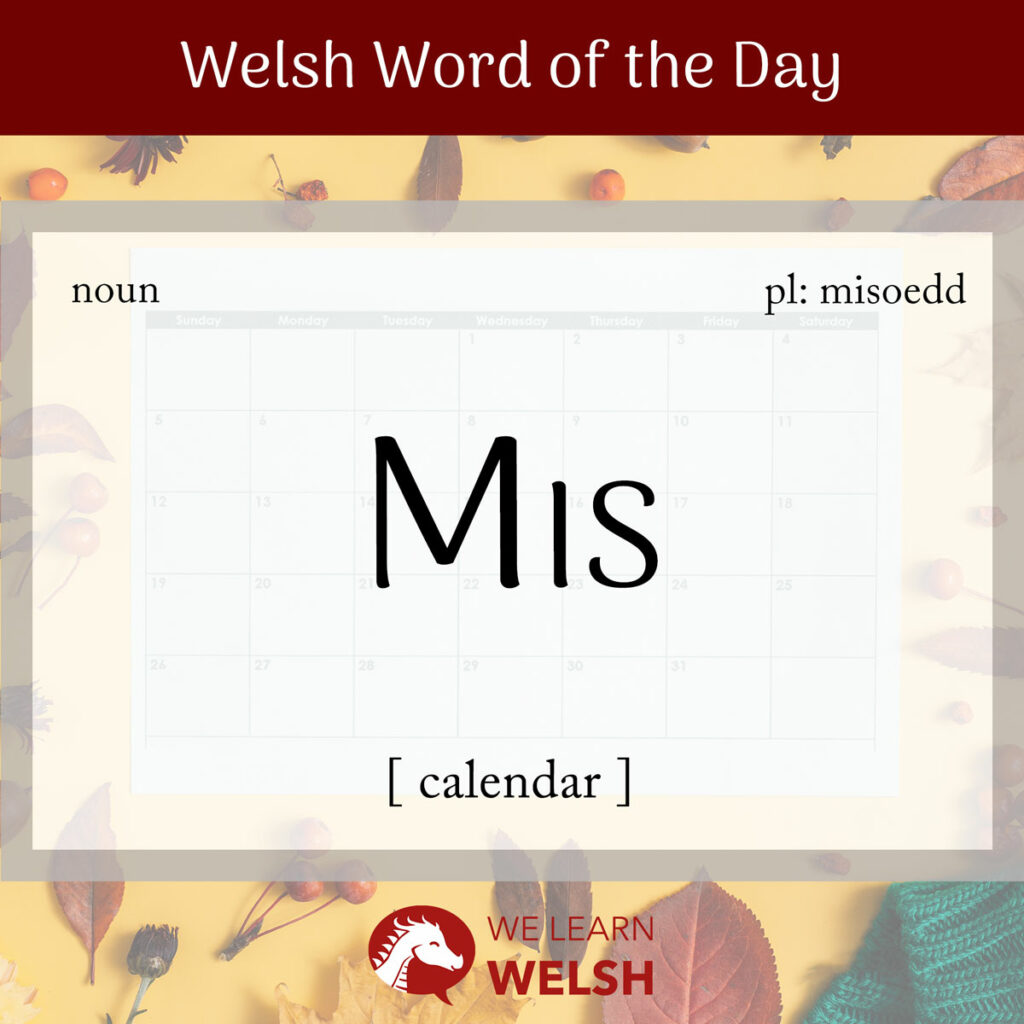The Welsh word for month is mis and the plural is misoedd.
mis
month
In South Wales, you may sometimes hear mis pronounced with a sh sound at the end, like this:
In general, it’s quite common in South Welsh pronunciation for s sounds at the end of words to shift to sh sounds.
Mis comes from the proto-Celtic *mins, meaning month, the same as the Breton miz and Cornish mîz. In turn, *mins is a descendant of the proto-Indo-European *mehnss, meaning either month or moon.
Indeed, the reason humans measure amser (time) in misoedd (months) is because they approximate the cycle of the lleuad (moon), which is roughly pedwar wythnos (four weeks), or wyth ar hugain diwrnod (twenty-eight days). Misoedd lloerol (lunar months) also measure the cylchred y mislif (menstrual cycle).
Many ancient calendrau (calendars) were primarily based on the lleuad, including the Coligny calendar. The Coligny calendar was used in modern-day Ffrainc (France) by continental Celts, so it’s possible that British Celts, including the indigenous Welsh, may have used a similar system to keep track of amser.
Mis is susceptible only to the soft mutation. Since it’s a masculine noun, it doesn’t mutate after y (the). However, as we’ll see shortly, it’s often used with prepositions, which are a common cause of mutations in Welsh.
Soft mutation
fis
Nasal mutation
N/A
Aspirate mutation
N/A
There are a couple of special words in Welsh to refer to a period of two consecutive months (deufis) and of three consecutive months (trifis). We may not have equivalents in English, but they come in handy! Other useful vocabulary includes unwaith y mis (once a month), mis i heddiw (a month from today), and of course, misol (monthly).
Here are the twelve misoedd of the blwyddyn (year):
- mis Ionawr = January
- mis Chwefror = February
- mis Mawrth = March
- mis Ebrill = April
- mis Mai = May
- mis Mehefin = June
- mis Gorffennaf = July
- mis Awst = August
- mis Medi = September
- mis Hydref = October
- mis Tachwedd = November
- mis Rhagfyr = December
As you can see, the word mis is used before the name of each month – it’s similar to saying July month in English, except it’s perfectly normal and natural in Welsh. The reason for this is believed to be clarity, as some Welsh month names have dual meanings. For example, mawrth is also the word for Tuesday (dydd Mawrth), and hydref, when used without the prefix mis, refers to the entire season of autumn.
Mae Nadolig ym mis Rhagfyr.
Christmas is in December.
However, in many situations, it’ll obvious that you mean the mis, so whether you include it when referring a specific month is often up to you.
For example, you could describe something that happens in December with the phrases yn Rhagfyr, ym mis Rhagfyr, or just fis Rhagfyr. In the last case, mis has mutated to fis – this happens when you are saying something is happening at a certain time, and are leaving out yn, which means in.
In general, you should include mis if you want to sound more formal, or if you’re writing something that needs to be really accurate and precise. You never need to omit mis, but be aware that other speakers might.
There are quite a few other prepositions that are likely to be used with the names of months. Here’s some that may come in handy.
- trwy fis Tachwedd = throughout November
- yn ystod mis Mawrth = during March
- o fis Gorffennaf = from July
- cyn mis Ionawr = before January
- ar ôl mis Hydref = after October

As I mentioned, hydref doubles as the name of the season autumn. The other seasons are gwanwyn (spring), haf (summer), and gaeaf (winter). There are some lovely descriptive Welsh words for more specific parts of the year, too. These include yr hirlwm (late winter), gefn gaeaf (deep winter), and canol haf (high summer).
Dw i’n mwynhau treulio mis Mai yng Nghymru.
I enjoy spending May in Wales.
It seems likely that ancient British Celts focussed mostly on gaeaf and haf, defined as the dark and light parts of the year. Cyntefin, Calan Mai or Calan Haf is the first of May, the same as Irish Beltane, and marks the beginning of the light half of the year. Calan Mai was celebrated with bonfires and dancing in Welsh villages until the 1800s, and many Welsh people are keen to revive the celebration of this cultural festival.
The dark half of the year begins on Calan Gaeaf, the first of November. Historically, the Welsh celebrate Calan Gaeaf by gathering to dance and light a bonfire, the same as for Calan Mai.
The twist is that once the fire goes out, everyone has to run home, as last person back runs the risk of being eaten by Yr Hwch Ddu Gota, a ghostly pig with no tail. This rather spooky tradition fits in quite well with modern day Halloween celebrations – anyone up for bringing it back?
Adref, adref, am y cynta’,
Hwch ddu gwta a gipio’r ola’.
Home, race home,
A tailless black sow will snatch the last.

